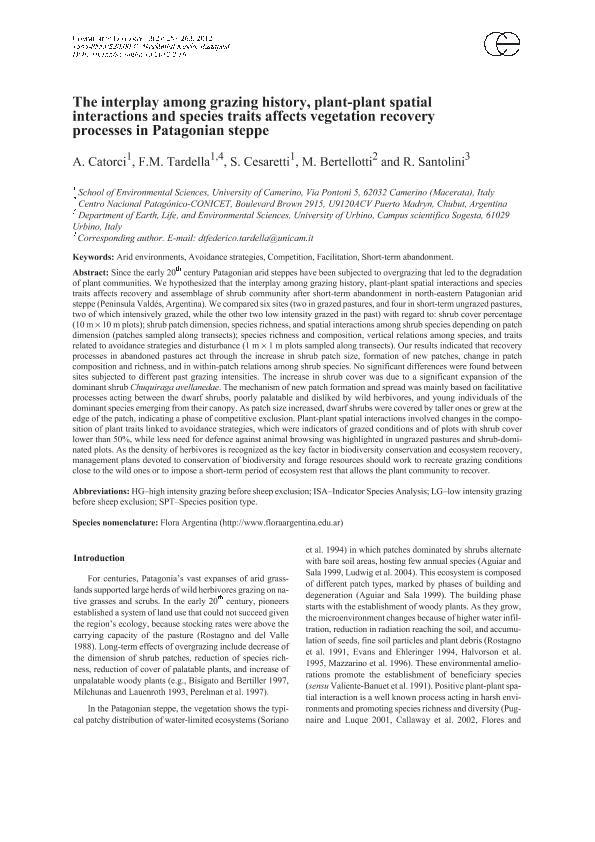Mostrar el registro sencillo del ítem
dc.contributor.author
Catorci, A.
dc.contributor.author
Tardella, F. M.
dc.contributor.author
Cesaretti, S.
dc.contributor.author
Bertellotti, Néstor Marcelo

dc.contributor.author
Santolini, R.
dc.date.available
2018-08-16T21:19:06Z
dc.date.issued
2012-12
dc.identifier.citation
Catorci, A.; Tardella, F. M.; Cesaretti, S.; Bertellotti, Néstor Marcelo; Santolini, R.; The interplay among grazing history, plant-plant spatial interactions and species traits affects vegetation recovery processes in Patagonian steppe; Akademiai Kiado; Community Ecology; 13; 2; 12-2012; 253-263
dc.identifier.issn
1585-8553
dc.identifier.uri
http://hdl.handle.net/11336/56035
dc.description.abstract
Since the early 20 century Patagonian arid steppes have been subjected to overgrazing that led to the degradation of plant communities. We hypothesized that the interplay among grazing history, plant-plant spatial interactions and species traits affects recovery and assemblage of shrub community after short-term abandonment in north-eastern Patagonian arid steppe (Peninsula Valdés, Argentina). We compared six sites (two in grazed pastures, and four in short-term ungrazed pastures, two of which intensively grazed, while the other two low intensity grazed in the past) with regard to: shrub cover percentage (10 m × 10 m plots); shrub patch dimension, species richness, and spatial interactions among shrub species depending on patch dimension (patches sampled along transects); species richness and composition, vertical relations among species, and traits related to avoidance strategies and disturbance (1 m × 1 m plots sampled along transects). Our results indicated that recovery processes in abandoned pastures act through the increase in shrub patch size, formation of new patches, change in patch composition and richness, and in within-patch relations among shrub species. No significant differences were found between sites subjected to different past grazing intensities. The increase in shrub cover was due to a significant expansion of the dominant shrub Chuquiraga avellanedae. The mechanism of new patch formation and spread was mainly based on facilitative processes acting between the dwarf shrubs, poorly palatable and disliked by wild herbivores, and young individuals of the dominant species emerging from their canopy. As patch size increased, dwarf shrubs were covered by taller ones or grew at the edge of the patch, indicating a phase of competitive exclusion. Plant-plant spatial interactions involved changes in the composition of plant traits linked to avoidance strategies, which were indicators of grazed conditions and of plots with shrub cover lower than 50%, while less need for defence against animal browsing was highlighted in ungrazed pastures and shrub-dominated plots. As the density of herbivores is recognized as the key factor in biodiversity conservation and ecosystem recovery, management plans devoted to conservation of biodiversity and forage resources should work to recreate grazing conditions close to the wild ones or to impose a short-term period of ecosystem rest that allows the plant community to recover.
dc.format
application/pdf
dc.language.iso
eng
dc.publisher
Akademiai Kiado

dc.rights
info:eu-repo/semantics/openAccess
dc.rights.uri
https://creativecommons.org/licenses/by-nc-sa/2.5/ar/
dc.subject
Arid Environments
dc.subject
Avoidance Strategies
dc.subject
Competition
dc.subject
Facilitation
dc.subject
Short-Term Abandonment
dc.subject.classification
Meteorología y Ciencias Atmosféricas

dc.subject.classification
Ciencias de la Tierra y relacionadas con el Medio Ambiente

dc.subject.classification
CIENCIAS NATURALES Y EXACTAS

dc.title
The interplay among grazing history, plant-plant spatial interactions and species traits affects vegetation recovery processes in Patagonian steppe
dc.type
info:eu-repo/semantics/article
dc.type
info:ar-repo/semantics/artículo
dc.type
info:eu-repo/semantics/publishedVersion
dc.date.updated
2018-07-23T17:21:11Z
dc.identifier.eissn
1588-2756
dc.journal.volume
13
dc.journal.number
2
dc.journal.pagination
253-263
dc.journal.pais
Hungría

dc.journal.ciudad
Budapest
dc.description.fil
Fil: Catorci, A.. Universita Degli Di Camerino. Scuola Di Scienze Ambientale; Italia
dc.description.fil
Fil: Tardella, F. M.. Universita Degli Di Camerino. Scuola Di Scienze Ambientale; Italia
dc.description.fil
Fil: Cesaretti, S.. Universita Degli Di Camerino. Scuola Di Scienze Ambientale; Italia
dc.description.fil
Fil: Bertellotti, Néstor Marcelo. Consejo Nacional de Investigaciones Científicas y Técnicas. Centro Nacional Patagónico; Argentina
dc.description.fil
Fil: Santolini, R.. University of Urbino; Italia
dc.journal.title
Community Ecology

dc.relation.alternativeid
info:eu-repo/semantics/altIdentifier/doi/http://dx.doi.org/10.1556/ComEc.13.2012.2.16
dc.relation.alternativeid
info:eu-repo/semantics/altIdentifier/url/https://akademiai.com/doi/abs/10.1556/ComEc.13.2012.2.16
Archivos asociados
